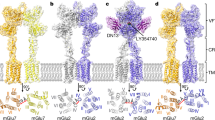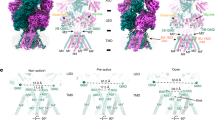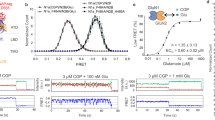Abstract
Excitatory neurotransmission mediated by NMDA (N-methyl-d-aspartate) receptors is fundamental to the physiology of the mammalian central nervous system. These receptors are heteromeric ion channels that for activation require binding of glycine and glutamate to the NR1 and NR2 subunits, respectively. NMDA receptor function is characterized by slow channel opening and deactivation, and the resulting influx of cations initiates signal transduction cascades that are crucial to higher functions including learning and memory. Here we report crystal structures of the ligand-binding core of NR2A with glutamate and that of the NR1–NR2A heterodimer with glutamate and glycine. The NR2A–glutamate complex defines the determinants of glutamate and NMDA recognition, and the NR1–NR2A heterodimer suggests a mechanism for ligand-induced ion channel opening. Analysis of the heterodimer interface, together with biochemical and electrophysiological experiments, confirms that the NR1–NR2A heterodimer is the functional unit in tetrameric NMDA receptors and that tyrosine 535 of NR1, located in the subunit interface, modulates the rate of ion channel deactivation.
This is a preview of subscription content, access via your institution
Access options
Subscribe to this journal
Receive 51 print issues and online access
$199.00 per year
only $3.90 per issue
Buy this article
- Purchase on SpringerLink
- Instant access to full article PDF
Prices may be subject to local taxes which are calculated during checkout






Similar content being viewed by others
References
Kandel, E. R., Schwartz, J. H. & Jessel, T. M. Essentials of Neural Science and Behavior 219–306 (Appleton & Lange, East Norwalk, Connecticut, 1995)
Watkins, J. C. & Evans, R. H. Excitatory amino acid transmitters. Annu. Rev. Pharmacol. Toxicol. 21, 165–204 (1981)
Hollmann, M., O'Shea-Greenfield, A., Rogers, S. W. & Heinemann, S. Cloning by functional expression of a member of the glutamate receptor family. Nature 342, 643–648 (1989)
Keinänen, K. et al. A family of AMPA-selective glutamate receptors. Science 249, 556–560 (1990)
Boulter, J. et al. Molecular cloning and functional expression of glutamate receptor subunit genes. Science 249, 1033–1037 (1990)
Werner, P., Voigt, M., Keinänen, K., Wisden, W. & Seeburg, P. H. Cloning of a putative high-affinity kainate receptor expressed predominantly in hippocampal CA3 cells. Nature 351, 742–744 (1991)
Moriyoshi, K. et al. Molecular cloning and characterization of the rat NMDA receptor. Nature 354, 31–37 (1991)
Johnson, J. W. & Ascher, P. Glycine potentiates the NMDA response in cultured mouse brain neurons. Nature 325, 529–531 (1987)
Mayer, M. L., Westbrook, G. L. & Guthrie, P. B. Voltage-dependent block by Mg2+ of NMDA responses in spinal cord neurones. Nature 309, 261–263 (1984)
MacDermott, A. B., Mayer, M. L., Westbrook, G. L., Smith, S. J. & Barker, J. L. NMDA-receptor activation increases cytoplasmic calcium concentration in cultured spinal cord neurones. Nature 321, 519–522 (1986)
Forsythe, I. D. & Westbrook, G. L. Slow excitatory postsynaptic currents mediated by N-methyl-D-aspartate receptors on cultured mouse central neurones. J. Physiol. 396, 515–533 (1988)
Vicini, S. et al. Functional and pharmacological differences between recombinant N-methyl-D-aspartate receptors. J. Neurophysiol. 79, 555–566 (1998)
Lester, R. A., Clements, J. D., Westbrook, G. L. & Jahr, C. E. Channel kinetics determine the time course of NMDA receptor-mediated synaptic currents. Nature 346, 565–567 (1990)
Cull-Candy, S., Brickley, S. & Farrant, M. NMDA receptor subunits: diversity, development and disease. Curr. Opin. Neurobiol. 11, 327–335 (2001)
Waxman, E. A. & Lynch, D. R. N-methyl-d-aspartate receptor subtypes: multiple roles in excitotoxicity and neurological disease. Neuroscientist 11, 37–49 (2005)
Benveniste, M. & Mayer, M. L. Kinetic analysis of antagonist action at N-methyl-d-aspartic acid receptors. Two binding sites each for glutamate and glycine. Biophys. J. 59, 560–573 (1991)
Clements, J. D. & Westbrook, G. L. Activation kinetics reveal the number of glutamate and glycine binding sites on the N-methyl-D-aspartate receptor. Neuron 7, 605–613 (1991)
Watanabe, M., Inoue, Y., Sakimura, K. & Mishina, M. Developmental changes in distribution of NMDA receptor channel subunit mRNAs. Neuroreport 3, 1138–1140 (1992)
Monyer, H., Burnashev, N., Laurie, D. J., Sakmann, B. & Seeburg, P. H. Developmental and regional expression in the rat brain and functional properties of four NMDA receptors. Neuron 12, 529–540 (1994)
Laurie, D. J. & Seeburg, P. H. Ligand affinities at recombinant N-methyl-d-aspartate receptors depend on subunit composition. Eur. J. Pharmacol. 268, 335–345 (1994)
Erreger, K., Chen, P. E., Wyllie, D. J. & Traynelis, S. F. Glutamate receptor gating. Crit. Rev. Neurobiol. 16, 187–224 (2004)
Ayalon, G. & Stern-Bach, Y. Functional assembly of AMPA and kainate receptors is mediated by several discrete protein-protein interactions. Neuron 31, 103–113 (2001)
Armstrong, N. & Gouaux, E. Mechanisms for activation and antagonism of an AMPA-sensitive glutamate receptor: crystal structures of the GluR2 ligand binding core. Neuron 28, 165–181 (2000)
Sun, Y. et al. Mechanism of glutamate receptor desensitization. Nature 417, 245–253 (2002)
Schorge, S. & Colquhoun, D. Studies of NMDA receptor function and stoichiometry with truncated and tandem subunits. J. Neurosci. 23, 1151–1158 (2003)
Meddows, E. et al. Identification of molecular determinants that are important in the assembly of N-methyl-d-aspartate receptors. J. Biol. Chem. 276, 18795–18803 (2001)
Regalado, M. P., Villarroel, A. & Lerma, J. Intersubunit cooperativity in the NMDA receptor. Neuron 32, 1085–1096 (2001)
Furukawa, H. & Gouaux, E. Mechanisms of activation, inhibition and specificity: crystal structures of the NMDA receptor NR1 ligand-binding core. EMBO. J. 22, 2873–2885 (2003)
Inanobe, A., Furukawa, H. & Gouaux, E. Mechanism of partial agonist action at the NR1 subunit of NMDA receptors. Neuron 47, 71–84 (2005)
Jin, R., Horning, M., Mayer, M. L. & Gouaux, E. Mechanism of activation and selectivity in a ligand-gated ion channel: structural and functional studies of GluR2 and quisqualate. Biochemistry 41, 15635–15643 (2002)
Armstrong, N., Sun, Y., Chen, G. Q. & Gouaux, E. Structure of a glutamate-receptor ligand-binding core in complex with kainate. Nature 395, 913–917 (1998)
Mayer, M. L. Crystal Structures of the GluR5 and GluR6 ligand binding cores: molecular mechanisms underlying kainate receptor selectivity. Neuron 45, 539–552 (2005)
Nanao, M. H., Green, T., Stern-Bach, Y., Heinemann, S. F. & Choe, S. Structure of the kainate receptor subunit GluR6 agonist-binding domain complexed with domoic acid. Proc. Natl Acad. Sci. U S A 102, 1708–1713 (2005)
Laube, B., Schemm, R. & Betz, H. Molecular determinants of ligand discrimination in the glutamate-binding pocket of the NMDA receptor. Neuropharmacology 47, 994–1007 (2004)
Watkins, J. C., Krogsgaard-Larsen, P. & Honore, T. Structure-activity relationships in the development of excitatory amino acid receptor agonists and competitive antagonists. Trends Pharmacol. Sci. 11, 25–33 (1990)
Choi, Y., Chen, H. V. & Lipton, S. A. Three pairs of cysteine residues mediate both redox and Zn2+ modulation of the NMDA receptor. J. Neurosci. 21, 392–400 (2001)
Folta-Stogniew, E. & Williams, K. R. Determination of molecular masses of proteins in solution: implementation of an HPLC size exclusion chromatography and laser light scattering service in a core laboratory. J. Biomol. Technol. 10, 51–63 (1999)
Stern-Bach, Y., Russo, S., Neuman, M. & Rosenmund, C. A point mutation in the glutamate binding site blocks desensitization of AMPA receptors. Neuron 21, 907–918 (1998)
Jin, R. et al. Mechanism of positive allosteric modulators acting on AMPA receptors. J. Neurosci. 25, 9027–9036 (2005)
Erreger, K., Dravid, S. M., Banke, T. G., Wyllie, D. J. & Traynelis, S. F. Subunit-specific gating controls rat NR1/NR2A and NR1/NR2B NMDA channel kinetics and synaptic signalling profiles. J. Physiol. 563, 345–358 (2005)
Otwinowski, Z. & Minor, W. Processing of X-ray diffraction data collected in oscillation mode. Methods Enzymol. 276, 307–326 (1997)
Terwilliger, T. C. & Berendzen, J. Automated MAD and MIR structure solution. Acta Crystallogr. D 55, 849–861 (1999)
Navaza, J. Amore: An automated package for molecular replacement. Acta Crystallogr. A 50, 157–163 (1994)
Read, R. J. Improved Fourier coefficients for maps using phases from partial structures with errors. Acta Crystallogr. A 42, 140–149 (1986)
Cowtan, K. D. & Main, P. Phase combination and cross validation in iterated density-modification calculations. Acta Crystallogr. D Biol. Crystallogr. 52, 43–48 (1996)
Brunger, A. T. et al. Crystallography & NMR system: A new software suite for macromolecular structure determination. Acta Crystallogr. D 54(5), 905–921 (1998)
Jones, T. A. & Kjeldgaard, M. Electron-density map interpretation. Methods Enzymol. 277, 173–208 (1997)
Yphantis, D., Johnson, M. L. & Lary, J. W. WinNONLIN106 program. (National Analytical Ultracentrifugation Facility, Univ. Connecticut, Storrs, CT, 1997).
Schuck, P. Size-distribution analysis of macromolecules by sedimentation velocity ultracentrifugation and lamm equation modeling. Biophys. J. 78, 1606–1619 (2000)
Kabsch, W. A solution for the best rotation to relate two sets of vectors. Acta Crystallogr. A 32, 922–923 (1976)
Acknowledgements
We are grateful to A. Rowe for comments on the sedimentation equilibrium data analysis. M. Mayer is thanked for discussions, critical reading of this manuscript, and pSP NR1-1a and NR2A. J. Howe and S. Traynelis are thanked for comments on electrophysiological experiments and for the TsA201 cell-line and pCINEO NR1-1a and NR2A, respectively. We thank N. Armstrong, W. Zhang, and A. Robert for instructions on the patch-clamp and rapid solution exchange experiments; R. Abramowitz and X. Yang for assistance with the X-ray experiments; S. Siegelbaum for providing Xenopus oocytes; and A. Sobolevsky and O. Boudker for critically reading the manuscript. The NR1 and NR2A cDNAs used in the structural analysis were a gift from S. F. Heinemann. S.K.S is supported by an NIH National Research Service Award postdoctoral fellowship. The Beckman XL-I analytical centrifuge was purchased with funds from the NIH. The work was supported by the NIH. E.G. is an investigator with the Howard Hughes Medical Institute.
Author information
Authors and Affiliations
Corresponding author
Ethics declarations
Competing interests
The coordinates and structure factors for NR1–NR2A S1S2 and NR2A S1S2–glutamate have been deposited in the Protein Data Bank with accession codes 2A5T and 2A5S, respectively. Reprints and permissions information is available at npg.nature.com/reprintsandpermissions. The authors declare no competing financial interests.
Supplementary information
Supplementary Notes
This file contains Supplementary Methods, Supplementary Figure Legends, Supplementary Tables 1–4 and Supplementary Figures 1–4. (PDF 2344 kb)
Rights and permissions
About this article
Cite this article
Furukawa, H., Singh, S., Mancusso, R. et al. Subunit arrangement and function in NMDA receptors. Nature 438, 185–192 (2005). https://doi.org/10.1038/nature04089
Received:
Accepted:
Issue Date:
DOI: https://doi.org/10.1038/nature04089
This article is cited by
-
Radical pair model for magnetic field effects on NMDA receptor activity
Scientific Reports (2024)
-
Uncovering the Significance of STEP61 in Alzheimer’s Disease: Structure, Substrates, and Interactome
Cellular and Molecular Neurobiology (2023)
-
Aß Pathology and Neuron–Glia Interactions: A Synaptocentric View
Neurochemical Research (2023)
-
Ferulic Acid Improves Synaptic Plasticity and Cognitive Impairments by Alleviating the PP2B/DARPP-32/PP1 Axis-Mediated STEP Increase and Aβ Burden in Alzheimer's Disease
Neurotherapeutics (2023)
-
Development and characterization of functional antibodies targeting NMDA receptors
Nature Communications (2022)



